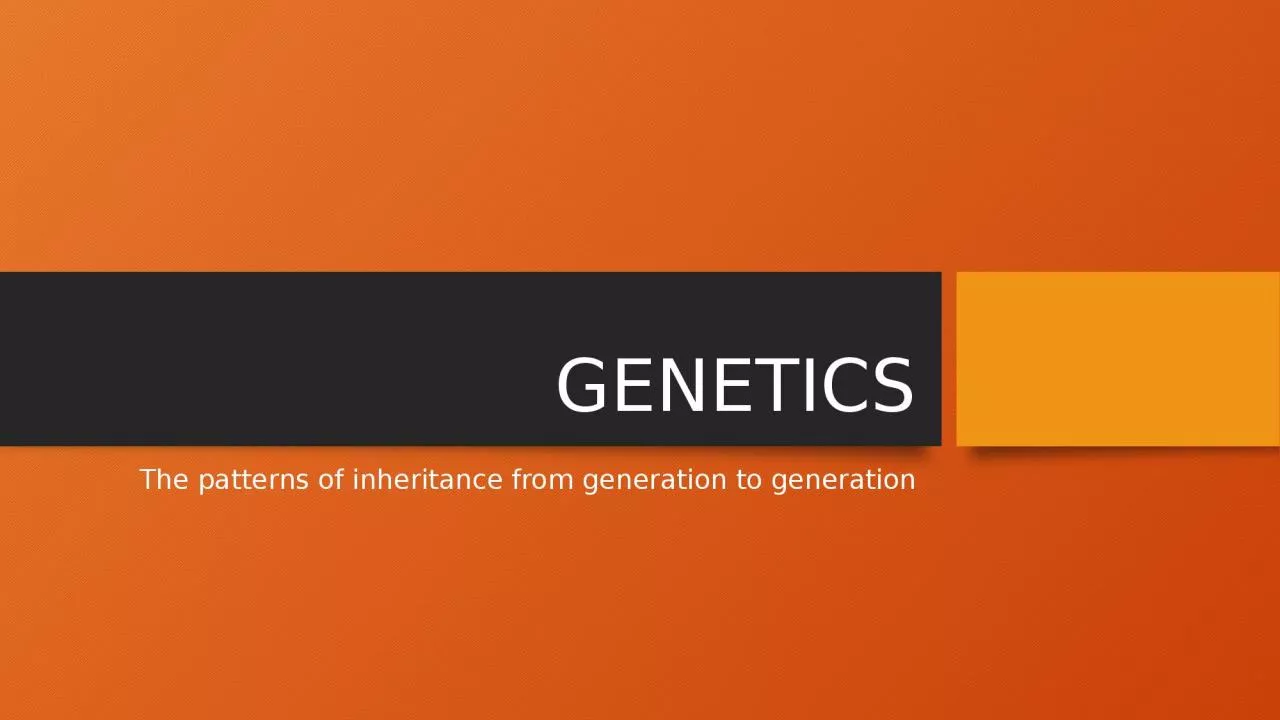

Learning objectives Understand and define the terms used in genetics Distinguish between dominant and recessive alleles Deduce the characteristics resulting from different genotypes Use a Punnet square to predict the outcomes of different genetic crosses ID: 1048601
Download Presentation The PPT/PDF document "GENETICS The patterns of inheritance fro..." is the property of its rightful owner. Permission is granted to download and print the materials on this web site for personal, non-commercial use only, and to display it on your personal computer provided you do not modify the materials and that you retain all copyright notices contained in the materials. By downloading content from our website, you accept the terms of this agreement.
1. GENETICSThe patterns of inheritance from generation to generation
2. Learning objectivesUnderstand and define the terms used in geneticsDistinguish between dominant and recessive allelesDeduce the characteristics resulting from different genotypesUse a Punnet square to predict the outcomes of different genetic crosses
3. Glossary
4. GlossaryThe observable physical or behavioral traits of an organism, determined by the organism's genotype.The alleles present in a particular individual that give rise to the individual's phenotype.A genotype where both alleles are the same, Either homozygous dominant AA or homozygous recessive aa.The F1 (first filial) generation is the hybrid offspring produced in the cross pollination of P (parental) generation true breeding plants.For a particular characteristic being studied, plants that, when self-pollinated, produce offspring with the same trait. These will have homozygous genotypes.An individual that results from a cross between two different strains. These individuals will be heterozygous.A set of segments of nucleic acid that contains the information necessary determine a particular characteristic.One of multiple alternative forms of a single gene. AlleleGenotypeHomozygousF1True BreedingHybridGenePhenotype
5. GenotypesA genotype is represented by two letters because chromosomes are found in pairsConsider the example of freckles: Let A be the allele for no freckles and a be the allele for frecklesWhich allele is dominant?Complete the tableGenotypeShown as:CharacterisiticsHomozygous dominantNo frecklesHeterozygousAaaafreckles
6. Link
7. Monohybrid Inheritance in Pea PlantsWhen Gregor Mendel crossed true-breeding tall plants with true-breeding short plants, the resulting offspring were all tall. These are the F1 plants.It is clear from this that the allele for tall is dominant over the allele for short, so we will assign the letter T for tall and t for short.
8. Genetic DiagramGive the phenotypesShow the genotypesWrite out the gametesDraw a Punnet squareState the ratiosTTttTTttAll tall plantsttTTTtTallTtTallTtTallTtTallpollenovaTallShort
9. Monohybrid Inheritance in Pea PlantsWhen he self-crossed the F1 plants, the resulting F2 pea plants were a mixture of tall and short plants in approximately a 3 tall:1 short ratio.Similar ratios were obtained when studying other pea characteristics.
10. Genetic DiagramGive the phenotypesShow the genotypesWrite out the gametesDraw a Punnet squareState the ratiosTtTtTtTt3 Tall: 1 DwarfTtTtTTTallTtTallTtTallttDwarfpollenovaTallTall
11. Learning ObjectivesUse counters to determine the outcomes of genetic crossesShow the importance of there being a large number of offspring in obtaining reliable genetic ratiosDistinguish between homozygous and heterozygousSuggest possible genotypes for dominant and recessive phenotpesUse punnet squares to determine phenotypic ratiosGive the genotypic and phenotypic outcomes as percentages
12. Crossing Tt with Tt (Two tall pea plants)EggSpermGenotypePhenotype
13. Crossing Tt with Tt (Two tall pea plants)GroupTallShort11642137315541555137Totals7228This gives an approximate ratio of:
14. Crossing Tt with tt (Tall vs short)EggSpermGenotypePhenotype
15. Crossing Tt with tt (Tall vs short)GroupTallShort12345TotalsThis gives an approximate ratio of:
16. Crossing Tt with tt (Tall vs short)Parent 1Parent 2RatioTall TTTall TTAll tall TTTall TTTall TtAll tall TT/TtTall TTShort ttAll tall TtTall TtTall Tt3 tall : 1 shortTall TtShort tt1 Tall : 1 shortShort ttShort ttAll short ttIf we know the genotypes of the parents we can predict the ratios of the offspringBy looking at the phenotypic ratios of the offspring, we can deduce (work out) the genotypes of the parents